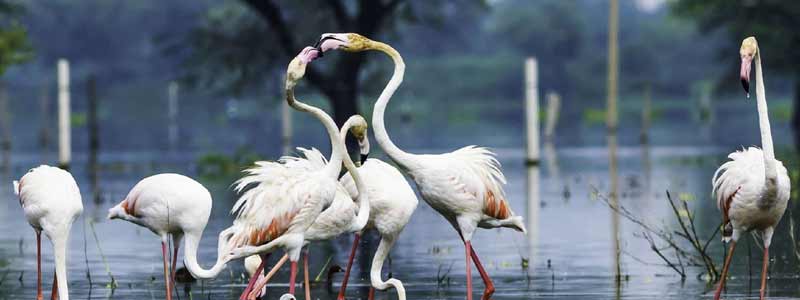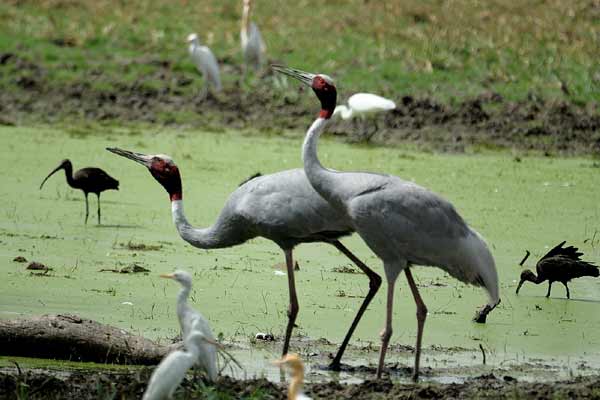Keoladeo Ghana National Park, Amongst one of the finest bird sanctuaries on the planet, Bharatpur Bird Sanctuary also called as Keoladeo Ghana National Park is a sanctuary that offers security to faunal species also. Keoladeo, the name gets from an old Hindu temple, which is dedicated to Lord Shiva and remains at the focal point of the national park. “Ghana” implies thick, alluding to the thick woods, which used to cover the region.
Settling indigenous water-feathered creatures and also transient water flying creatures and waterside winged creatures, this haven is likewise possessed by Sambar, Chital, Nilgai, and Boar. While a large portion of India’s park has been produced from the chasing predicament of royal India, Keoladeo, famously known as Bharatpur Wildlife Sanctuary, is maybe the main situation where the environment has been made by a maharaja. In prior times, Bharatpur town used to be flooded frequently every monsoon.
In 1760, an earthen dam (Ajan Dam) was developed, to spare the town, from this yearly idea of nature. The sorrow made by extraction of soil for the dam was cleared and this turned into the Bharatpur Lake. Though the Bharatpur Bird Sanctuary is open around the year, but still, the best time to visit Bharatpur Bird Sanctuary is from August to November to witness the resident birds and from October to February to get the sight of migratory birds.

History Of Bharatpur Bird Sanctuary
Keoladeo Ghana National Park is a man-made garden, Maharaja Suraj Mal of Bharatpur built this bird sanctuary 250 years ago. There is a temple of Lord Shiva in the centre of this garden which is known as Keoladeo here, hence the name of this garden was named Keoladeo.
There is a natural slope at this place, due to this, at that time flood situation was created at this place during the rainy season, to avoid this, Maharaja Surajmal constructed the “Ajan Bund” here in the middle of 1726-1763. The dam was constructed at the site of two rivers “Gambhiri and Banganga Sangam” flowing here.
From 1850 onwards, the kings of Keoladeo Ghana National Park started using this place as a hunting ground. Along with this, the king started organizing annual bird hunting in this zoo to keep the British Viceroy happy. In 1938, the then British Viceroy of India, Lord Linlithgow, along with his colleague Victor Hope, hunted over 4,273 birds a day, with the largest number of birds such as “Mallards and Teals” being hunted on that day.
Under the Rajasthan Forest Act 1953, this Bird Sanctuary has been included in the category of a reserved forest, the last hunting in this Bird Sanctuary was organized in 1964, the former Maharaja of Bharatpur reserved the rights to hunt here till 1972. On 13 March 1976, the area was given the status of a Keoladeo Ghana National Park, and in October 1981, under the Wetland Convention, the place was given the status of a Ramsar site.
This Bird Sanctuary got the status of National Park on 10 March 1982, since then the name of the Bird Sanctuary has become Keoladeo Ghana National Park. At the World Heritage Convention held in 1985, this National Park has declared a UNESCO World Heritage Site.
After being declared a national park, in 1982, the government banned farming and protecting domesticated cattle and taking fodder within the protected forest, leading to many violent clashes with local residents and the government over the region, eventually In 2004, the government had to accept the demands of the farmers, after which the government drastically cut the water being sent to this zoo.
The water supply to this park was reduced from 15,000,000 cubic feet earlier to just 510,000 cubic feet. Since this decision of the government, there has been a huge change in the natural environment of this garden which was very terrible, after the water cut, most of the marshy land here has become pleasantly useless, resulting in those who come here for breeding.
Most migratory birds now fly away to Garhmukteshwari in Uttar Pradesh, located near the river Ganges, 90 km from this place.
Flora & Fauna in Keoladeo National Park
Keoladeo National Park is spread across 2,873 hectares of woodlands, grasslands, wetlands & woodland swamps. The vegetation here is of a dry deciduous type, with medium sized trees & shrubs found inside its forest. Some of the trees which can be commonly spotted inside the park are kadam, jamun, babul, kandi, ber, kair & piloo.
Keoladeo Ghana National Park is home to 370 species of birds. A large number of aquatic birds from Afghanistan, Turkmenistan, Siberia & China visit the park. In fact, it is the only region in India where the critically endangered Siberian Crane can be spotted during the winters. Some of the birds which you can expect to spot here are cranes, pelicans, eagles, wagtails, spotted bill duck, white breasted kingfisher, moor hen, painted stork, partridge, magpie robin, honey buzzard, rose ringed parakeet & green footed yellow pigeon.
Attractions in Keoladeo Ghana National Park
The main attractions for tourists visiting the Keoladeo Ghana Park are the migratory birds, which come from as far away as Siberia and Central Asia to spend their winters in Bharatpur, before returning back to their breeding grounds. Some of the migratory birds that visit Keoladeo Ghana National Park include several species of Cranes, Hawks, Pelicans, Geese, Shanks, Ducks, Eagles, Warblers, Stints, Wagtails, Buntings, Wheatears, Flycatchers, Larks, Pipits etc. Besides the migratory and resident birds, other tourist attractions in Keoladeo Ghana bird sanctuary include the Bharatpur government Museum, Lohagarh Fort and Deeg Palace.
Bird watching
Morning is the best time for bird watching. The best way to see the diverse species of birds and animals is to make trips at different times of the day. Wake up with the birds in the early morning, see water birds in daylight and, of course, catch night birds such as owls at dusk and after sunset.
Safari at Bharatpur Sanctuary
A unique way to discover the vegetation and wildlife at the Keoladeo Ghana National Park is the Safari here, which takes you right through the heart of the forests. There are basically three options to choose from when it comes to the safari here – Elephant Back Safari, Jeep Rides and Rickshaw Safari. If you wish to spot birds more closely Rickshaw Safari is the best option for you.
Jeep Safari will take you through the jungles of the sanctuary, where you can get a closer look at the vegetation and animals here. Jeeps can be booked outside the main entrance of Bharatpur Bird Sanctuary. You can also hire bicycles from the entrance to explore the National Park. Other details for the same are:-
- Timings: 6:00 AM to 6:00 PM
- Safari Fee (Indian tourists): INR 25
- Safari Fee (Foreign tourists): INR 200
- Rickshaw Safari Fee: INR 800-1000 per rickshaw for the entire day
- Video Camera: INR 200
You can take your own vehicle up to Shanti Kutir which is approximately 2 km from the main entrance of the park. The charges for the same is INR 50.
Best Time To Visit Bharatpur National Park
Keoladeo Ghana National Park is located in the Bharatpur district of Rajasthan. The climate of Rajasthan is very hot, from March to the onset of monsoon in July, the summer temperature in this state easily reaches 50 degrees.
This has a direct effect on the migratory birds of this sanctuary, due to which migratory birds move away from this place during the summer season and only a few species of local birds are seen in this park. The rains are very less in Rajasthan even during the monsoon season, after the water is flooded in the marshy ground of this garden, small islands are formed here which have created a favourable environment for breeding migratory birds.
Due to the marshy land here, the soil of this garden becomes very slippery during the monsoon season, which is not right for tourism. The monsoon departs after September and by October, the cold starts increasing here.
The cold season is the best time for breeding migratory birds, and during the winter season, thousands of migratory birds come to migrate to this bird sanctuary. If you are also planning to see this bird sanctuary, then the winter season will be the best for you.
How To Reach Bharatpur Bird Sanctuary
- By Air: Jaipur, New Delhi, and Agra are the nearest airport to Keoladeo Ghana National Park. Once you reach any of these airports, you can board a taxi or cab to reach Bharatpur Bird Sanctuary.
- By Rail: The closest railway station to Bharatpur Bird Sanctuary is Bharatpur Junction. Several trains run from all the major cities in India to Bharatpur.
- By Road: Many private buses frequently run from Udaipur, Agra, Ajmer, Jodhpur to Bharatpur bus stop. NH-11 connects Bharatpur with Agra (5 hours, 56 km), Delhi (5 hours, 176 km) and Jaipur (6 hours, 176 km) from where tourists prefer to drive. Once you reach Bharatpur, you can hire a cab or taxi to reach Bharatpur Bird Sanctuary.
Frequently Asked Questions About Keoladeo National Park
Q. What is the best time to visit Keoladeo National Park?
Keoladeo Ghana National Park can be visited any time of the year, as it is open throughout the year. August to November is the best time to visit it to spot the resident breeding birds, while October to February is when you can spot a variety of migrant birds. Some migratory birds however, can also be spotted during March. During the winters, it can get quite foggy both during the day and the night.
Q. What kind of safaris are available at Keoladeo National Park?
Cycle/rickshaw/horse tongas safaris are conducted inside the Bharatpur National Park. Safaris start from 8 AM and are available till 5 PM. Most tourists prefer taking the cycle rickshaw safari as it’s noiseless & lets them spot a greater number of birds. You can also rent bicycles and take a cycle tour of the park. To hire a cycle, you will have to submit your identification card at the counter.
Q. What are the park timings of Keoladeo National Park?
The park is open from 6:30 AM to 5 PM during winters, and 6 AM to 6 PM throughout the rest of the year.
Q. How to reach Keoladeo National Park?
By Air: The nearest airport is Agra Airport, situated about 56 kilometers from Bharatpur. Taxis can be hired from the airport to reach Bharatpur.
By Rail: Bharatpur Railway Station is just about 5 kilometers away from the bird sanctuary.
By Road: NH 11 connects the maj
